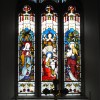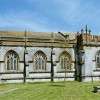The Church took a great interest in Bridport Harbour from its earliest days. Considering that Bridport rope making had royal support, this may not be surprising. The harbour, which was to receive ships from as far as Russia, was in existence in the 13th century and in 1444 the Bishop of Sarum ‘granted an indulgence’ for its repair.
Sixteen ships were built here in the Napoleonic wars alone. In 1856 a vessel of over 1,000 tons was launched in the present harbour at West Bay, and defeating the notorious silting-up of the harbour entrance was able to put to sea. To give some indication of her size, although built for the open sea she could probably just have navigated the Gloucester to Sharpness canal, which was then the widest canal in the country.
Twenty years later saw the end of wooden shipbuilding of any size. The last wooden vessel, the ‘Lilian,’ took the water in 1879. Today, fishing, including trawling, is carried on and there is much pleasure boating, the harbour being filled with small craft, but the import and export trade has been lost.
A large number of ships were registered in Bridport, many of them being built there.
Ships once sailed the mile up the river Brit to the town but it became silted up. On the river near Bridport is the significantly named Port Mill, where flax was boiled, or softened by blows of heavy timber.
West Bay Harbour was improved in 1744 and in 1830, as many as 528 ships were recorded as using it, sailing in and out of the long narrow entrance as they do today. Hemp and flax were imported on a large scale at the height of the rope making industry. But by 1881, only two-tenths of the harbour dues of 50 years before were collected.
West Bay, where the present harbour is, was separated from the town by a flood plain, over which for hundreds of years ran rough tracks. The first road was laid down in 1819 and in 1884 the Great Western railway line was extended to the port.
All through its history the harbour has had a struggle with the elements: mainly south westerlies from which there was no shelter, and high tides. Yet coastal and foreign vessels continued to trade: from Russia came hemp and flax and from Scandinavia timber.
The flax and hemp were vital to the town. In 1793, a total of 1,800 Bridport people and 7,000 from the areas around were employed in the rope and net trade. Most of Bridport’s buildings today date from the second half of the 18th century when the trade prospered.
At the harbour in West Bay large sailing ships were built in a yard where Heron Court stands. West Bay at one time had six slipways, which could be used for launching and repairing vessels or for just beaching them.
So which was the great ship of over 1,000 tons, which was launched here? It was the ‘Speedy,’ which sailed out of the Dorset harbour on her trials soon after taking the water in 1856. Shifting sands and shingle at the mouth of the Brit made it a hazardous task to take out or bring in such large craft.
Massive harbour works at the mouth of the river have taken place over the years.
Going back to the beginnings of the port, in the late 13th century the Abbot of Cerne held land on the east and west cliffs at West Bay. And the Prior of Frampton was making the most of any wrecks coming on to the shore. At that period vessels were coming up to the town up the river, and remains of moorings have been found and are visible at low water there.
In 1326, with invasion imminent, a survey was carried out around the coasts of all ships of 50 tons and upwards but Bridport was omitted from the list, indicating that only very small vessels were able to come up the Brit. By 1395, a Customs officer was on duty at Bridport, about the time that the river-mouth was converted into a better harbour.
In 1446 work took place on the maintenance of the harbour, but for the next 300 years the entrance was continually choked with shingle.
Piers, sluices and wharves were constructed in a four-year programme in the mid-1700. But the harbour was again choked with sand in 1818. In 1823 to 1825 further improvements were made, using 200 men. As a result, Bridport became a full bond port in 1832 and trade flourished until the railway came to West Bay in the late 19th century.
The work done in the port in the 18th century meant there was a depth of at least 11 feet of water between the piers at all spring tides, allowing vessels of 100 tons to enter or leave. Later, of course, the entrance had to be deepened for ships up to 10 times that size.
Already, back in 1751 the new harbour was considered to be “a safe port where may ride about 40 sail.” Nicholas Bools (or Bowles) established a shipyard. And the first vessel built was the ‘North Star,’ of 52 tons, in 1769.
It has been calculated that some 400 ships were launched between then and 1879, including smacks, schooners, luggers, cutters and even barques, brigs and brigantines.
A privateer, the ‘Resolution’ was built in 1779 during the American War of Independence. A privateer was an armed vessel and officered by private individuals holding a government commission, and authorised for war service.
So we see that the intensive shipping activity was inseparably linked with the prosperity of Bridport. Without the harbour the rope making could not have flourished, and without the trade that developed there might still be just a shingle river-mouth opening on to the sea. Few boats and a popular yet quiet seaside resort for those living in Dorset and beyond to enjoy.
This is the heritage of Bridport’s great industry of times past. And for those with maritime interests, these are among the proud ships that took the water in its harbour, when it was in its heyday:
‘Abby’ (schooner, 1837,159 tons); ‘Aberdeen Packet’ (sloop, 125 tons); ‘Britannia’ (301 tons); ‘Lord Donoughmore’ (cutter, 80tons); ‘Portia’ (barque, 1861, 298 tons); ‘Rutland’ (cutter, 1797, 82 tons); and ‘Good Intent’ (sloop. 1788, 36 tons). Each must have had a tale to tell.



